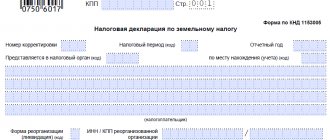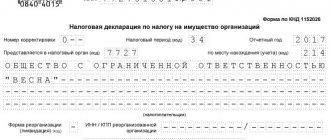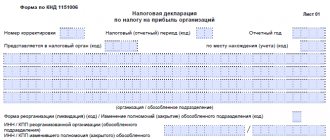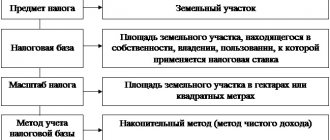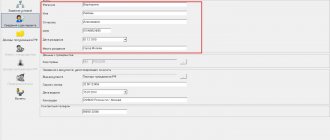There is very little time left to submit your land tax return. And this year there is also a new form of land tax declaration. Let's talk about everything in order.
Only tax payer organizations are required to report on land tax. These are companies that own or permanently use land. When renting or free use of land, you do not need to pay tax.
Our article is about how to fill out a land tax return for 2021.
Land tax declaration: deadlines
The declaration should be submitted when the tax period ends, i.e. calendar year. The declaration is submitted to the Federal Tax Service at the location of the land plot, and the largest taxpayers submit it at their place of registration.
Firms that have several plots located on the territory subordinate to one Federal Tax Service, submit a land tax declaration in one copy, and each object must be reflected on a separate sheet of Section 2. And if the territories where the plots are located belong to different inspections, then the declarations are also submitted for each separately (letter of the Federal Tax Service of the Russian Federation dated 08/07/2015 No. BS-4-11/13839).
The submission deadline is annually, no later than February 1 of the year following the reporting year. Organizations need to report for 2021 no later than February 1, 2021.
If the land tax return is submitted late, the organization will be fined, and the fine for each month of “delay” will be 5% of the tax unpaid according to the return, but not more than 30% in the amount and not less than 1000 rubles. (clause 1 of article 119 of the Tax Code of the Russian Federation).
Electronic filing of the declaration is mandatory for organizations with an average number of employees over 100 people; others have the right to report on paper (clause 3 of Article 80 of the Tax Code of the Russian Federation).
Results
All companies owning land plots are required to report land tax for 2021 by February 3, 2021.
The declaration is filled out in a familiar form, and control ratios are used to verify it. The number of declarations submitted depends on the number of the company’s own land plots, as well as their location.
Sources:
- Tax Code of the Russian Federation
- Order of the Federal Tax Service of Russia dated August 30, 2018 No. ММВ-7-21/ [email protected]
You can find more complete information on the topic in ConsultantPlus. Free trial access to the system for 2 days.
The new land tax declaration form includes:
- Title page,
- Section 1 – the amount of tax payable to the budget,
- Section 2 – calculation of the base and amount of land tax.
Text fields are filled in in printed capital letters, and cost indicators are indicated in full rubles, taking into account rounding rules: discarding the amount up to 50 kopecks, and 50 kopecks. and more, rounded to the nearest ruble. If there is no indicator in the cells, a dash is placed.
When submitting a land tax return 2017 in a “paper” format, the report is printed on only one side of the sheet, and all pages are numbered consecutively. A stapler is not used to fasten sheets together, and a proofreader cannot be used to correct errors.
Who should fill it out?
The general list of entities that have a legislative obligation to pay land tax is listed in Art. 398 Tax Code of the Russian Federation. In accordance with this article, the payers in this case are the owners of land plots located within the municipality or cities of federal significance.
They may fall into one of the following categories:
- legal entities (state, municipal or private forms of ownership);
- individuals-citizens;
- individuals who are registered as individual entrepreneurs (IP);
At the same time, they must own land with the following rights:
- property;
- lifelong inheritable ownership (in this case, land is provided only to citizens);
- unlimited use.
As for tenants and owners of land with the right of free use (fixed-term or indefinite, it makes no difference), they are excluded from the list of payers.
In addition, the category of land is also important - some types of plots are also not subject to taxation.
All entities that own land plots on one of the three rights listed above and do not have any benefits are required to pay this tax. However, legal entities have one more additional obligation - filling out and submitting a special tax document, that is, a declaration.
As for individual entrepreneurs, who before 2015 also had to submit a declaration, for them this obligation was canceled after certain amendments were made to the Tax Code of the Russian Federation.
Now these entities pay tax calculated by the Federal Tax Service and displayed in the corresponding notification.
Filling out a land tax return
The declaration is filled out taking into account the requirements of the rules contained in Appendix No. 3 to Order No. MMV-7-21/347. All necessary codes are included in appendices No. 1-6.
Title page
Filling out the title is traditional: at the top of the page (and on each completed sheet) indicate your TIN, checkpoint and serial number of the page.
The adjustment number is “0—” for the primary report, and when submitting an updated declaration – “2—”, “3—”, etc.
The tax period code is “34”, and for companies reporting in connection with liquidation/reorganization – “50”. Year – “2017”.
Next, indicate the code of the Federal Tax Service where the declaration is submitted, and the submission code at the location of the land - “270”. The name of the organization is indicated in full without abbreviations.
The date and signature of the taxpayer (manager) or his representative are placed at the bottom.
Section 2
First, you need to calculate the tax, for which we will fill out section 2 of the “land tax 2017” declaration for legal entities.
The tax base is calculated separately for each object - a plot of land, a share of a plot, or a share in the right to it. To do this, you need to fill out several sections 2, according to the number of taxable objects of the organization.
In the first lines, indicate the cadastral number of the land.
BCC (line 010) is indicated by the location of the site: within the boundaries of cities, villages, etc.
The OKTMO code (line 020) corresponds to the municipality on whose territory the land plot is located.
The land category code (line 030), according to its purpose, is selected from Appendix No. 5.
Line 040 is filled in by companies carrying out construction on the site.
The cadastral value (line 050) is taken into account as of January 1 of the reporting year. The cost of the plot in the land tax return for 2021 is taken as of 01/01/2017.
Line 060 is filled in as a simple fraction, indicating the share in the right to the plot.
Next, in subsection I the tax base is calculated: on lines 070-100 the codes and amount of tax benefits (non-taxable amount, or area), if any, and on line 110 - the cadastral value as of 01/01/2017, or the standard price of land.
In subsections II and III, we will calculate the amount of tax: indicate the tax rate in force at the location of the site (line 120) and the number of full months of ownership of this land in 2021 (line 130). If the plot was owned for an incomplete tax period, then it is necessary to apply the coefficient (line 140), calculated in accordance with clause 5.16 of the Procedure for filling out the declaration.
The tax amount (line 150) is determined as the product of lines 110, 120 and 140, divided by 100.
Lines 160 – 240 are filled out if appropriate benefits are available.
The final amount of tax payable (line 250) is reflected as the difference between the tax (line 150) and benefits (lines 190, 210, 230).
Section 1
The obtained result is transferred to the blocks of lines in Section 1 for each land plot, indicating the corresponding BCC and OKTMO.
We take the calculated tax (line 021) from line 250 of section 2. On lines 023-027 we will reflect advance payments payable during the year.
The difference between tax and advances is reflected in line 030 if the result is positive, or 031 if negative. Below you can see an example of filling out a land tax return for 2017.
How to fill out the title page?
The title page of the form contains information about who is submitting the document and for what time period. The new form, effective from 2021, requires the following information:
- INN and KPP of a legal entity assigned to it by the Federal Tax Service, the recipient of the report. The exception is the largest taxpayers who indicate the checkpoint at the place of registration.
- Correction no. If the declaration is submitted for the first time, “0” is indicated, if after making corrections – “1”, “2” and so on in order.
- Code designation of the tax period for which data is presented.
- The year for which the fiscal liability was calculated.
- The name of the reporting author according to the registration documents.
- Telephone number for contact.
- The number of pages on which the report is compiled.
- The number of sheets of appendices to them. For example, if a one-page power of attorney confirming the signatory’s authority is attached to the form, “1” is indicated.
For organizations that are at the stage of reorganization, three special fields are required to be filled in: code, tax identification number and checkpoint of the reorganized structure.
At the bottom of the title page is the full name of the person confirming the accuracy of the data presented. To indicate its status, the accountant chooses one of two codes:
- “1” – the individual entrepreneur himself or the director of a commercial structure;
- “2” – another official.
If the document is endorsed not by the manager, but by a representative, the details of the document confirming his authority must be written down.
At the bottom of the first sheet there is a special section filled out by employees of the Federal Tax Service. It reflects, among other things, the method of submitting the declaration, the date of its receipt and the number of sheets.
Who rents it out, options for providing it
If a legal entity or individual entrepreneur owns a land plot, then annually he must report to the tax office. What is meant by land plots, and who must submit tax data?
- Agricultural enterprises, communities that use land to grow produce and make a profit.
- Country and gardening societies that own plots of land used for household farming.
- Various land holdings on which industrial buildings are located that help conduct economic or production activities.
- Zones of forest land, which are owned in part by groups of citizens.
- Areas designated for health-improving enterprises and tourist centers.
There are a number of land plots that are officially exempt from the need to calculate and pay taxes. These include:
- Land fund, which is the property of the state.
- A number of sites that were withdrawn from circulation in accordance with the legislation of the Russian Federation.
- Areas that are of cultural and historical value.
- Areas allocated for the construction of multi-storey buildings.
At the end of the year, the organization’s accountant collects all the necessary information in a report. The declaration is submitted to the tax authority in two ways:
- With the help of electronic reporting programs, the document is drawn up and submitted electronically via the Internet.
- Personally by the manager or employee for whom the corresponding power of attorney has been issued. The document is filled out and submitted on paper.
General filling rules
All sections of the declaration must be completed in accordance with the requirements contained in the Order.
The most important of them include:
- The values of all cost indicators must be entered in full rubles. If after calculations the indicator turns out to be in kopecks, then it is rounded in accordance with the general arithmetic rules: if there are less than 50 kopecks, then downwards, otherwise - up.
- All pages of the document are numbered consecutively. It starts with the Title Page and does not depend on the number of sections being filled out, as well as their presence or absence. The page number is written in a special field from left to right in the following form: 005 - for the third page, 015 - for the fifteenth, 105 - for the one hundred and fifth.
- Correcting errors using corrective means is not permitted. Also prohibited are erasures, typos or typos in the text, bold strikethroughs, and the use of an eraser or proofreader. If it is necessary to make changes, erroneous information must be crossed out with one thin line, after which the correct information must be indicated next to it, as well as the signature and surname of the person who made the entry.
- When filling out the declaration, the following colors of ink can be used: black, blue, violet. The text can be handwritten or typed on a computer. All letters in text fields must be printed.
- Double-sided printing of the form is not permitted. Each page should be printed on a separate sheet. It is also prohibited to fasten sheets in ways that could harm the paper medium (for example, stitching or stapling).
- All fields are filled in from left to right, starting from the first familiarity. Each field is intended for entering only one indicator (except for fractions, which can occupy several fields). If any of the indicators is missing, then a dash is entered in the corresponding field.
In principle, these requirements are not unique - they are established for most declarations and official documents that are submitted to government agencies.
However, compliance with them is mandatory, otherwise the document may be refused.
The declaration can be submitted both in paper and electronic form, using special telecommunication channels provided for in the Tax Code of the Russian Federation.
When submitting a document in paper form, it is necessary to prepare two copies of it, since one will be submitted to the tax authority, and the second, with the appropriate mark, will be returned to the payer. This can be done in person, by mail or through a legal representative.
